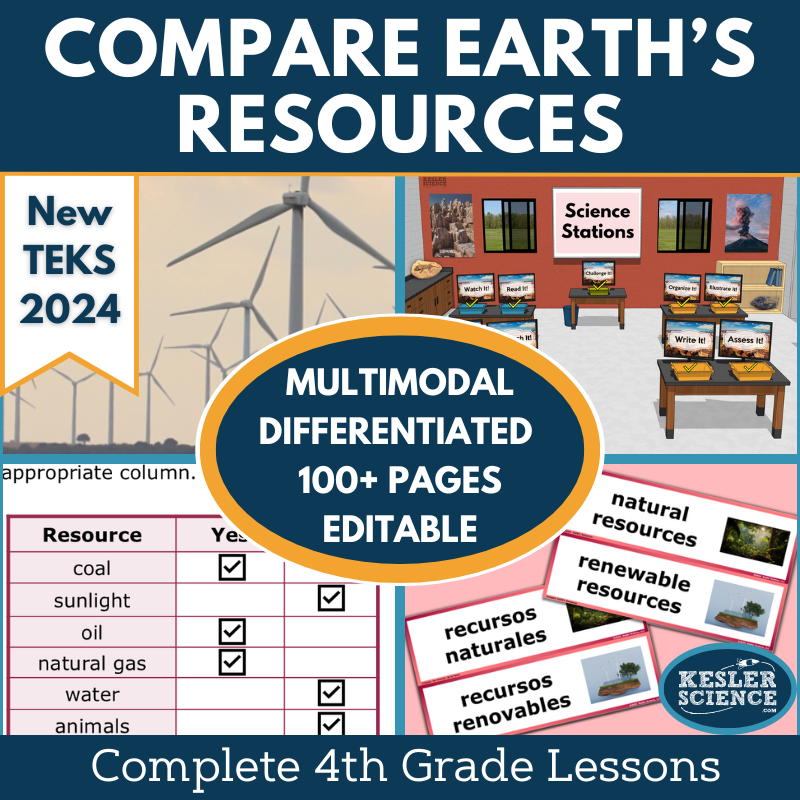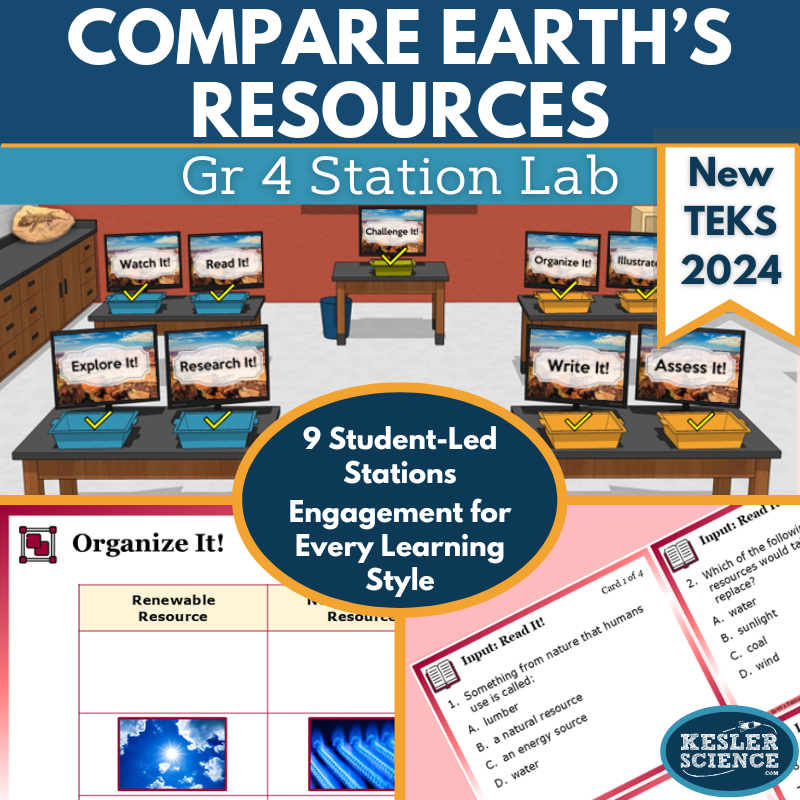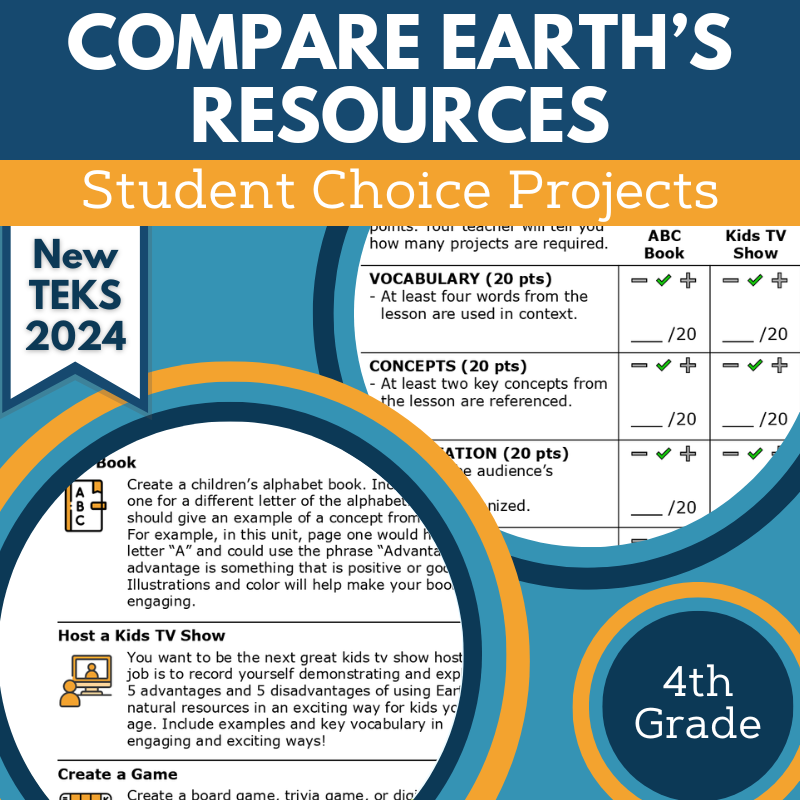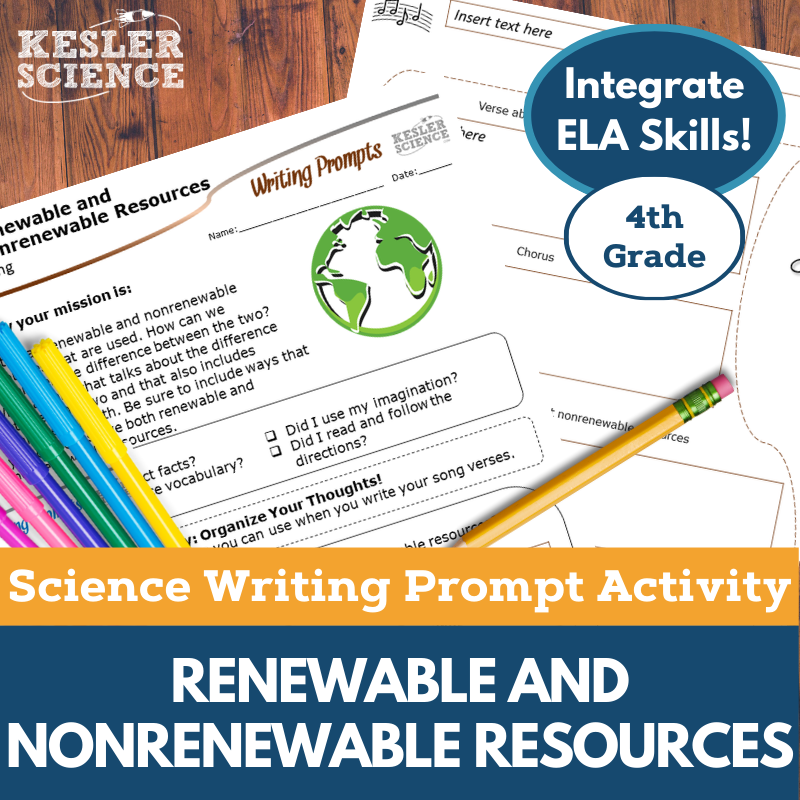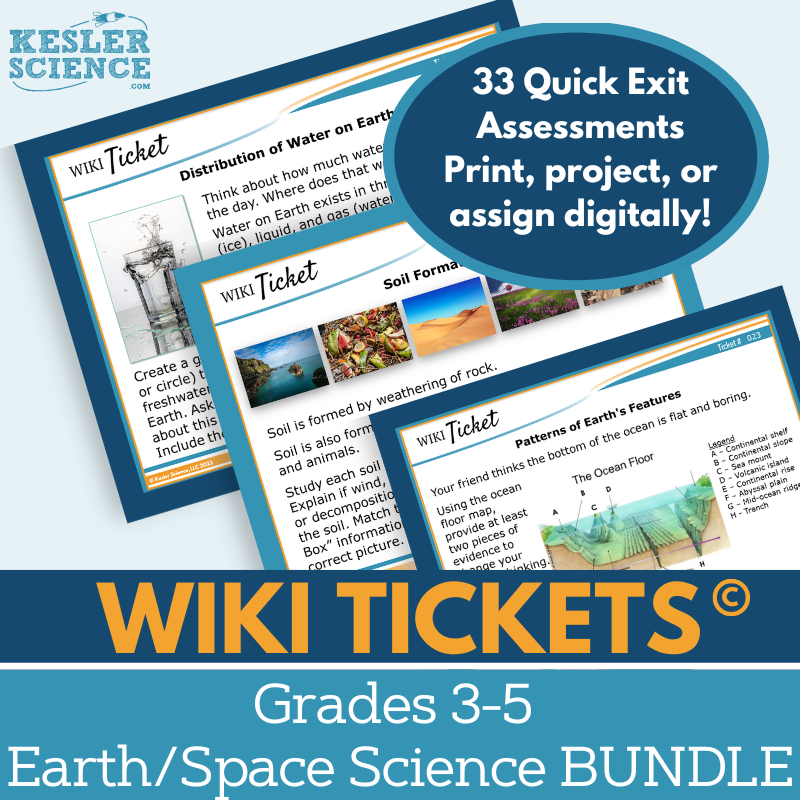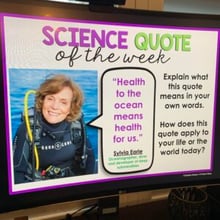Compare Earth's Resources Activities for 4th Grade Science
This 5E lesson on Earth’s natural resources guides 4th-grade students in exploring the pros and cons of renewable and nonrenewable resources like wind, water, sunlight, plants, animals, coal, oil, and natural gas. Aligned with TEKS 4.11A, it includes editable presentations, worksheets, projects, and assessments, with materials available in English and Spanish for digital or print use. Students engage in discussions, hands-on labs, experiments, reading, and research, demonstrating understanding through sorting tasks, writing prompts, and illustrations. The resource also offers interactive notebooks, student-choice projects, and STAAR 2.0-aligned assessments, suitable for classroom or virtual learning. The resources below will give students a comprehensive understanding of renewable and nonrenewable resources. All of the following materials are also included in the Kesler Science Membership.
This Kesler Science 5E Lesson on Earth’s natural resources is designed for 4th-grade students to explore the advantages and disadvantages of renewable and nonrenewable resources such as wind, water, sunlight, plants, animals, coal, oil, and natural gas. The unit includes editable presentations, worksheets, choice projects, and assessments, all aligned with the 2021 TEKS 4.11A standard. Materials are differentiated for various learning needs, with Spanish translations and multimodal resources available for both digital and printable formats.
Following the 5E Model, the lesson begins with engagement activities like vocabulary cards and class discussions. Exploration involves a hands-on, student-led station lab with activities such as experiments, reading passages, online research, and videos. Students demonstrate understanding through sorting tasks, writing prompts, illustrations, and assessments. Explanation materials include editable PowerPoints and interactive notebook templates in English and Spanish. Elaboration offers student-choice projects, while evaluation provides STAAR 2.0-aligned assessments and review questions. This flexible resource is ideal for in-class or virtual learning environments.
This Kesler Science 5E Lesson on Earth’s natural resources is designed for 4th-grade students to explore the advantages and disadvantages of renewable and nonrenewable resources such as wind, water, sunlight, plants, animals, coal, oil, and natural gas. The unit includes editable presentations, worksheets, choice projects, and assessments, all aligned with the 2021 TEKS 4.11A standard. Materials are differentiated for various learning needs, with Spanish translations and multimodal resources available for both digital and printable formats.
Following the 5E Model, the lesson begins with engagement activities like vocabulary cards and class discussions. Exploration involves a hands-on, student-led station lab with activities such as experiments, reading passages, online research, and videos. Students demonstrate understanding through sorting tasks, writing prompts, illustrations, and assessments. Explanation materials include editable PowerPoints and interactive notebook templates in English and Spanish. Elaboration offers student-choice projects, while evaluation provides STAAR 2.0-aligned assessments and review questions. This flexible resource is ideal for in-class or virtual learning environments.
Engage your 4th-grade class with this student-led station lab aligned with the 2021 TEKS 4.11A standard. Students will explore Earth's natural resources, both renewable and nonrenewable, while examining the advantages and disadvantages of each. Designed for in-person or virtual learning, this interactive lesson encourages student-driven discovery through nine differentiated stations.
Students engage with new concepts through activities like hands-on exploration, videos, readings, and research, with resources available in both English and Spanish. They demonstrate understanding by organizing information, illustrating examples, writing responses, and completing assessments. A bonus challenge station offers extension activities for advanced learners. This low-prep, high-engagement resource promotes critical thinking and personalized learning.
Engage your 4th-grade class with this student-led station lab aligned with the 2021 TEKS 4.11A standard. Students will explore Earth's natural resources, both renewable and nonrenewable, while examining the advantages and disadvantages of each. Designed for in-person or virtual learning, this interactive lesson encourages student-driven discovery through nine differentiated stations.
Students engage with new concepts through activities like hands-on exploration, videos, readings, and research, with resources available in both English and Spanish. They demonstrate understanding by organizing information, illustrating examples, writing responses, and completing assessments. A bonus challenge station offers extension activities for advanced learners. This low-prep, high-engagement resource promotes critical thinking and personalized learning.
The Compare Earth's Resources Student Choice Projects align with the 2021 TEKS Earth science standard 4.11A, giving 4th graders the opportunity to select a project that suits their preferred output style. A project page outlines six student-led options and a “design your own” project, along with an editable rubric for teacher, peer, or self-assessment. This resource is also included in the Compare Earth's Resources Complete Lesson for TEKS 4.11A.
These flexible, multimodal projects allow students to demonstrate their understanding creatively and personally. Two versions of the project page support differentiation, offering modified options for students needing remediation and challenges for advanced learners. Teachers can adjust the rubric to fit their grading needs.
The resource includes nine project options plus a “design your own” feature, teacher directions for guidance, and editable rubrics assessing vocabulary, concepts, presentation, clarity, and accuracy. The projects use standard classroom supplies like paper, markers, and scissors, with many options available for digital completion.
The Compare Earth's Resources Student Choice Projects align with the 2021 TEKS Earth science standard 4.11A, giving 4th graders the opportunity to select a project that suits their preferred output style. A project page outlines six student-led options and a “design your own” project, along with an editable rubric for teacher, peer, or self-assessment. This resource is also included in the Compare Earth's Resources Complete Lesson for TEKS 4.11A.
These flexible, multimodal projects allow students to demonstrate their understanding creatively and personally. Two versions of the project page support differentiation, offering modified options for students needing remediation and challenges for advanced learners. Teachers can adjust the rubric to fit their grading needs.
The resource includes nine project options plus a “design your own” feature, teacher directions for guidance, and editable rubrics assessing vocabulary, concepts, presentation, clarity, and accuracy. The projects use standard classroom supplies like paper, markers, and scissors, with many options available for digital completion.
The Renewable and Nonrenewable Resources Science Writing Prompt engages 4th-grade students in creatively demonstrating their understanding of Earth's resources through a mission writing prompt. This activity encourages science reasoning and exploration while enhancing writing skills, making it ideal for both in-person and virtual learning.
Aligned with TEKS and NGSS standards, this low-prep, student-centered resource is perfect for elaboration, review, or enrichment. It includes teacher directions with answer guides, project ideas, and rubrics; projection-friendly prompts for classroom or virtual display; full-sized and half-sheet handouts for various uses; and a digital interactive PowerPoint version, compatible with Google Slides.
This versatile activity can be used for cross-curricular projects, formative assessments, early finisher tasks, extra credit, make-up work, TELPAS samples, or differentiation exercises. It also works well for classroom displays or as part of a student anthology. Designed for review, it assumes students have prior knowledge of the topic or access to research materials.
The Renewable and Nonrenewable Resources Science Writing Prompt engages 4th-grade students in creatively demonstrating their understanding of Earth's resources through a mission writing prompt. This activity encourages science reasoning and exploration while enhancing writing skills, making it ideal for both in-person and virtual learning.
Aligned with TEKS and NGSS standards, this low-prep, student-centered resource is perfect for elaboration, review, or enrichment. It includes teacher directions with answer guides, project ideas, and rubrics; projection-friendly prompts for classroom or virtual display; full-sized and half-sheet handouts for various uses; and a digital interactive PowerPoint version, compatible with Google Slides.
This versatile activity can be used for cross-curricular projects, formative assessments, early finisher tasks, extra credit, make-up work, TELPAS samples, or differentiation exercises. It also works well for classroom displays or as part of a student anthology. Designed for review, it assumes students have prior knowledge of the topic or access to research materials.
The WIKI Tickets© formative assessments offer a fun and engaging way to check 3rd–5th grade students’ understanding of Earth and Space Science. This set includes 33 assessments, each available in five formats: a full-screen projection version, three printable handouts (full, split, and quarter-page sizes), and an interactive digital version compatible with PowerPoint and Google Slides.
Aligned with NGSS and TEKS standards for upper elementary science, each standard is covered by at least one ticket, with some topics featuring multiple assessments. A table of contents is also included to show standard alignment. These versatile assessments can be used in both classroom and virtual learning environments.
Topics include air temperature, wind direction, precipitation, Earth’s rotation, natural resources, weather patterns, soil properties, the water cycle, and more. WIKI Tickets© can serve as exit tickets, bellringers, or quick checks for understanding. They can be projected for whole-class participation, printed for individual use, or assigned digitally in 1:1 or remote learning settings.
The WIKI Tickets© formative assessments offer a fun and engaging way to check 3rd–5th grade students’ understanding of Earth and Space Science. This set includes 33 assessments, each available in five formats: a full-screen projection version, three printable handouts (full, split, and quarter-page sizes), and an interactive digital version compatible with PowerPoint and Google Slides.
Aligned with NGSS and TEKS standards for upper elementary science, each standard is covered by at least one ticket, with some topics featuring multiple assessments. A table of contents is also included to show standard alignment. These versatile assessments can be used in both classroom and virtual learning environments.
Topics include air temperature, wind direction, precipitation, Earth’s rotation, natural resources, weather patterns, soil properties, the water cycle, and more. WIKI Tickets© can serve as exit tickets, bellringers, or quick checks for understanding. They can be projected for whole-class participation, printed for individual use, or assigned digitally in 1:1 or remote learning settings.
Year-Round Resources
These year-round activities will increase your students' understanding of many middle school science topics. All of these activities are also included in the Kesler Science Membership.
Visual Data & Graphing
You're not alone if your students struggle with understanding graphs, charts, and tables. It's a skill that takes an enormous amount of practice. This resource will help students build a strong foundation in analyzing data and creating their own data visualizations.
Bell Ringers and Warm-Ups
These middle school science bell ringers are an excellent way to engage your students as soon as they walk into your classroom. This comprehensive FULL YEAR resource includes everything you need to start off each science class with an interesting warm-up activity.
Review Board Games
Each game board has been carefully designed to keep students engaged. There are 10 different action spaces on each board and dozens of question cards. All of the actions are related to science concepts and keep the students motivated throughout the game.
Each game is ready to play. Simply print out the board and the cards and let the students enjoy reviewing nine different units.
Essential Questions and Standards
Below are the essential questions and standards associated with the lessons and activities included in the atoms unit. This topic is only one of more than 100 middle school science topics included in the Kesler Science Membership.
-
Identify Earth’s renewable and nonrenewable natural resources.
-
Explain the advantages and disadvantages of each type of resource.
-
TEKS Science - 4.11A Compare Earth's Resources
Kesler Science Membership
Imagine never having to search for another middle school science lesson again. The membership gives you access to ALL of the Kesler Science products in one place (Yes, including everything above).
Say goodbye to long hours of lesson prep.

